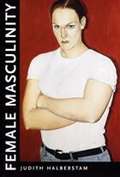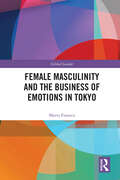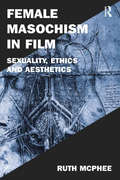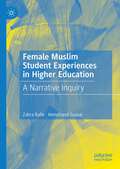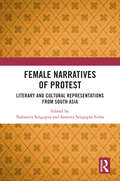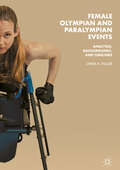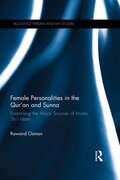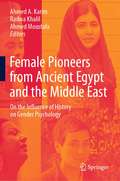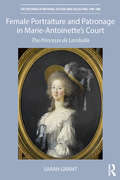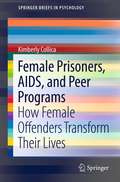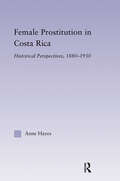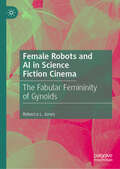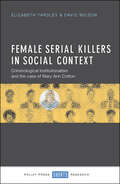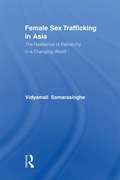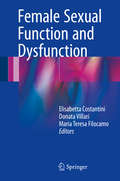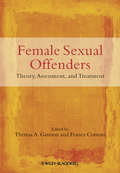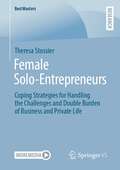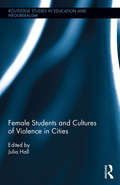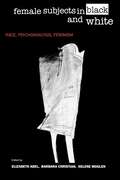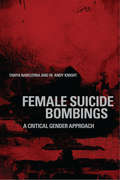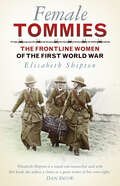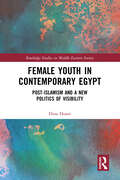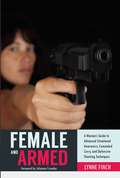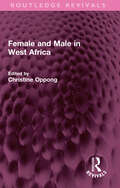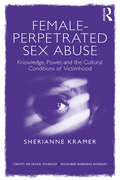- Table View
- List View
Female Masculinity
by Judith HalberstamMasculinity without men. In Female Masculinity Judith Halberstam takes aim at the protected status of male masculinity and shows that female masculinity has offered a distinct alternative to it for well over two hundred years. Providing the first full-length study on this subject, Halberstam catalogs the diversity of gender expressions among masculine women from nineteenth-century pre-lesbian practices to contemporary drag king performances.Through detailed textual readings as well as empirical research, Halberstam uncovers a hidden history of female masculinities while arguing for a more nuanced understanding of gender categories that would incorporate rather than pathologize them. She rereads Anne Lister's diaries and Radclyffe Hall's The Well of Loneliness as foundational assertions of female masculine identity. She considers the enigma of the stone butch and the politics surrounding butch/femme roles within lesbian communities. She also explores issues of transsexuality among "transgender dykes"--lesbians who pass as men--and female-to-male transsexuals who may find the label of "lesbian" a temporary refuge. Halberstam also tackles such topics as women and boxing, butches in Hollywood and independent cinema, and the phenomenon of male impersonators.Female Masculinity signals a new understanding of masculine behaviors and identities, and a new direction in interdisciplinary queer scholarship. Illustrated with nearly forty photographs, including portraits, film stills, and drag king performance shots, this book provides an extensive record of the wide range of female masculinities. And as Halberstam clearly demonstrates, female masculinity is not some bad imitation of virility, but a lively and dramatic staging of hybrid and minority genders.
Female Masculinity and the Business of Emotions in Tokyo (Global Gender)
by Marta FanascaFemale Masculinity and the Business of Emotions in Tokyo investigates the novel “emotion business” of dansō escorting as a phenomenon emerging between gender performativity and pop-culture, commodified relationships and the wish for self-expression. Fanasca documents the dreams, ambitions and fears of young crossdresser escorts negotiating their identity with and within the Japanese society, as well as those of crossdresser escorts’ clients: women looking for the perfect man and the opportunity to experience emotions. Combining anthropological, sociological and gender studies theories with an ethnographic approach, Fanasca argues that dansō crossdressing is the tool used by a sector of Japanese women to resist the heteronormative and patriarchal society and its expectations, while reinventing themselves and their identities looking for self-actualization. Female Masculinity and the Business of Emotions Tokyo is an interdisciplinary work which will interest both scholars and students of Japanese studies, gender studies, and anthropology.
Female Masochism in Film: Sexuality, Ethics and Aesthetics (Film Philosophy at the Margins)
by Ruth McPheeTheoretically and representationally, responses to heterosexual female masochism have ranged from neglect in theories that focus predominantly or only upon masochistic sexuality within male subjects, to condemnation from feminists who regard it as an inverted expression of patriarchal control rather than a legitimate form of female desire. It has commonly been understood as a passive form of sexuality, thus ignoring the potential for activity and agency that the masochistic position may involve, which underpins the crucial argument that female masochism can be conceived as enquiring ethical activity. Taking as its subject the works of Jane Campion, Catherine Breillat, Michael Haneke and Lars von Trier as well as the films Secretary (Steven Shainberg), Dans Ma Peau (Marina de Van), Red Road (Andrea Arnold, 2006) Amer (Hélène Cattat and Bruno Forzani), and Sleeping Beauty (Julia Leigh), Female Masochism in Film avoids these reductive and simplistic approaches by focusing on the ambivalences and intricacies of this type of sexuality and subjectivity. Using the philosophical writings of Kristeva, Irigaray, Lacan, Scarry, and Bataille, McPhee argues that masochism cannot and should not be considered aside from its ethical and intersubjective implications, and furthermore, that the aesthetic tendencies emerging across these films - obscenity, extremity, confrontation and a transgressive, ambiguous form of beauty - are strongly related to these implications. Ultimately, this complex and novel work calls upon the spectator and the theorist to reconsider normative ideas about desire, corporeality, fantasy and suffering.
Female Muslim Student Experiences in Higher Education: A Narrative Inquiry
by Hemchand Gossai Zahra RafieThis ethnographic study explores the lived experiences and challenges felt by Muslim female students in higher education in the greater District of Columbia, Maryland, and Virginia (DMV) area. It offers narrative case studies as a form of narrative inquiry based on stories of lived experience as a means of capturing dynamic, didactic, and dialectic understandings to promote and enable needed change in higher education. In centering the voices of Muslim female students, this research goes beyond the narrow statistical representation of predefined categories to examine and present the systematic nature and roots of social prejudice.
Female Narratives of Protest: Literary and Cultural Representations from South Asia
by Nabanita Sengupta and Samrita Sengupta SinhaThis book explores the complex assemblage of biopolitics, citizenship, ethics and human rights concerns in South Asia focusing specifically on women poets, writers and artists and their explorations on marginalisation, violence and protest. The book traces the origins, varied historiographies and socio-political consequences of women’s protests and feminist discourses. Bringing together narratives of the Landais from Afghanistan, voices from Pakistan, Bangladesh and Sri Lanka, Miya women poets writing from Assam, and stories of Dalit and queer women across the region, it analyses the diverse modes of women’s protests and their ethical and humanitarian cartographies. The volume highlights the reconfiguration of female voices of protest in contemporary literature and popular culture in South Asia and the formation of closely-knit female communities of solidarity, cooperation and collective political action. The book will be of interest to students and researchers of gender studies, literature, cultural studies, sociology, minority and indigenous studies, and South Asian studies.
Female Olympian and Paralympian Events: Analyses, Backgrounds, and Timelines
by Linda K. FullerFemale Olympian and Paralympian Events is a groundbreaking book that examines women’s sports in the Olympic and Paralympic Games, which have long been underappreciated and under-analyzed. The book begins with a brief background on women’s participation in the Olympic Games and their role relative to the International Olympic Committee, then introduces the underlying Gendered Critical Discourse Analysis theory used throughout the book’s analysis before delving into a literature review of female Olympians and Paralympians’ events. It includes a listing of noteworthy “firsts” in the field, followed by individual discussions of twenty-eight Summer and seven Winter events, analyzed according to their historical, rhetorical, and popular cultural representations. Women’s unique role(s) in the various events are discussed, particular athletes and Paralympic events are highlighted, and original tables are also included. At the end of each section, affiliated organizations and resources are included in this invaluable referential volume.
Female Personalities in the Qur'an and Sunna: Examining the Major Sources of Imami Shi'i Islam (Routledge Persian and Shi'i Studies)
by Rawand OsmanThis book investigates the manner in which the Qur’an and sunna depict female personalities in their narrative literature. Providing a comprehensive study of all the female personalities mentioned in the Qur’an, the book is selective in the personalities of the sunna, examining the three prominent women of ahl al-bayt; Khadija, Fatima, and Zaynab. Analysing the major sources of Imami Shi‘i Islam, including the exegetical compilations of the eminent Shi‘i religious authorities of the classical and modern periods, as well as the authoritative books of Shi’i traditions, this book finds that the varieties of female personalities are portrayed as human beings on different stages of the spiritual spectrum. They display feminine qualities, which are often viewed positively and are sometimes commendable traits for men, at least as far as the spiritual domain is concerned. The theory, particularly regarding women’s humanity, is then tested against the depiction of womanhood in the hadith literature, with special emphasis on Nahj al-Balagha. Contributing a fresh perspective on classical materials, this book will be of interest to students and scholars of Islamic Studies, Women’s Studies and Shi’i Studies.
Female Pioneers from Ancient Egypt and the Middle East: On the Influence of History on Gender Psychology
by Ahmed Moustafa Ahmed A. Karim Radwa KhalilThis book explores the contributions of Eastern female pioneers in science, politics and arts from Ancient Egypt to modern times, and discusses the possible psychological and social impact of this knowledge on today’s gender role in Eastern and Western Societies. Based on psychological studies on social learning, the book argues that profound knowledge of the historical contributions of Eastern female pioneers in science, politics and arts can improve today’s gender roles in Middle Eastern countries and inspire young women living in Western Societies with Eastern migration background. Spanning disciplines such as Natural sciences, Neuroscience, Psychology, Sociology, Islamic Theology, History and Arts, and including contributions from diverse geographical regions across the world, this book provides an elaborate review of the gender role of women in Ancient Egypt and the Middle East, outlining their prominence and influence and discusses the possible psychological and social impact of this knowledge on today’s gender roles.
Female Portraiture and Patronage in Marie Antoinette's Court: The Princesse de Lamballe (The Histories of Material Culture and Collecting, 1700-1950)
by Sarah GrantThis comprehensive book brings to light the portraits, private collections and public patronage of the princesse de Lamballe, a pivotal member of Marie-Antoinette’s inner circle. Drawing extensively on unpublished archival sources, Sarah Grant examines the princess’s many portrait commissions and the rich character of her private collections, which included works by some of the period’s leading artists and artisans. The book sheds new light on the agency, sorority and taste of Marie-Antoinette and her friends, a group of female patrons and model of courtly collecting that would be extinguished by the coming revolution.
Female Prisoners, AIDS, and Peer Programs
by Kimberly CollicaThis book highlights a neglected area in the field of rehabilitation of female offenders with AIDS. It provides data to show how women, working as HIV peer educators in prison, utilize their peer experiences as a transition point for rehabilitation both inside and outside of the penitentiary. HIV and prison are inextricably linked and education has proved to be the one constant that mitigates the spread of both HIV and crime. Research on female inmates in general is not frequent and this book presents unique qualitative data that includes rich accounts from the women themselves. It illustrates the benefits derived by female inmates who work in an HIV prison-based peer program, while adding to the criminology literature on female patterns of criminality and rehabilitation. It provides a greater understanding of how prison programs affect the processes of criminal desistance and behavioral changes for female inmates. Women involved in such programming are able to change the criminal trajectory of their life direction. contributing to reduced levels of recidivism and institutional disciplinary infractions. The implications for these programs is relevant within the broader perspective of women, HIV and incarceration.
Female Prostitution in Costa Rica: Historical Perspectives, 1880-1930
by Anne HayesThis book analyzes the development of female prostitution in the Pacific port of Puntarenas, Costa Rica during the advanced stage of the coffee exporting economy (1880-1930), at the height of the consolidation of the liberal state. Hayes argues that prostitution in the port differed from that of the coffee producing highlands due to differential economic, social, and political development. In the periphery of Puntarenas, the development of prostitution reflected a less stigmatized view of sexual commerce than that of the highlands, where prostitution, although legal, threatened the tenets of liberal nationalism based on racial homogeneity and family values. Women of the highlands were encouraged to reproduce the nation's "more European" stock of workers and to ensure the legal transference of property through legal church marriages - both part of a design to stabilize the coffee exporting project. By contrast, prostitutes and other working women of Puntarenas, many immigrants from the "less European" populations of neighboring regions and most in concubinage, were freer to do what the law prescribed - register as prostitutes in legitimate trade. Such regional disparities reveal weaknesses in traditional explanations of Costa Rican exceptionalism, which have rested on the premise of cultural homogeneity and have reflected the realities of only one region of the country. The book advances an alternative explanation for the development of the nation's more democratic institutions, situating Costa Rican exceptionalism in the nation's free labor system, of which the labor prostitute in Puntarenas provides an example.
Female Robots and AI in Science Fiction Cinema: The Fabular Femininity of Gynoids
by Rebecca L. JonesThis book is the first comprehensive overview of the history of female-presenting AI and robots in US and UK live-action, science fiction films from 1949 to 2023. It offers an original taxonomy that aids in the examination of 80 films and over 135 characters&’ representations, starting with The Perfect Woman (1949) and ending with Robots (2023). Using its representational taxonomy, this book analyses the evolution of these depictions, showing the continuations, revisions, and shifts in the depiction of female-presenting AI and robots from objectified, eroticised, subordinated things to being autonomous moral agents who assert their right to equality and refuse their abusive, typically sexual, use. This book shows how these fictional, gendered constructions are products of a heterosexual, cisgender, male fantasy of an idealised, subordinated form of femininity. These artificial characters, along with their real-world counterparts, highlight a desire for a subordinated femininity, but also show how that subordination is a social construction often reinforced and countered in onscreen depictions. By examining the trends within its asserted Galatea, Girlfriend, Mother, and Deadly Seductress types, this book presents an exploration of what our female-presenting artificial creations could be, while addressing their contemporary, and our current, AI technologies, and how science fiction is influencing real life, while our reality seeks to mirror science fiction.
Female Serial Killers in Social Context: Criminological Institutionalism and the Case of Mary Ann Cotton
by David Wilson Elizabeth YardleyTo date, approaches to understanding serial murder have focused on individual cases rather than the social context in which they occurred. Written by leading criminologists and world experts on serial murder, this book marks a departure by situating nineteenth century serial killer Mary Ann Cotton within the broader social structure. Using archival records of her court appearances, local histories and newspaper articles, it uniquely explores how institutions such as the family, economy and religion shaped the environment she inhabited and her social integration through the roles of wife, mother, worker and criminal. Acknowledging that it takes a particular type of individual to commit serial murder, the book shows that it also takes a particular type of society to enable that murderer to go unseen. As the first work to analyse serial murder through the theoretical framework of institutional criminology and institutional anomie theory, it will equip criminologists with a methodological toolkit for performing institutional analysis.
Female Sex Trafficking in Asia: The Resilience of Patriarchy in a Changing World (Routledge International Studies of Women and Place #Vol. 5)
by Vidyamali SamarasingheTrafficking of women and girls for purposes of sexual exploitation across the globe is widely acknowledged as a leading criminal activity. Women of poor countries are particularly vulnerable to sex trafficking. This book identifies the patterns, causes and consequences of female sex trafficking in Nepal, Cambodia and the Philippines. Using empirical evidence this book illustrates the commonalities and the differences among the different countries and recommends that serious attention should be paid to location-specific dimensions of sex trafficking in designing anti-sex trafficking strategies.
Female Sexual Function and Dysfunction
by Elisabetta Costantini Donata Villari Maria Teresa FilocamoThis book discusses all aspects of sexuality in women and in particular explores sexual function and dysfunction in a variety of settings, including the different stages of life and a wide range of major diseases and local conditions. The aim is to refocus attention on the needs and sexual realities of women, providing a fresh point of view that will assist gynecologists, sexual medicine physicians, and urologists in delivery of high-quality care and help women themselves to understand and address sexual problems relating to desire, arousal, orgasm, and sexual pain. Psychological aspects of female sexuality and the impacts of the aging process, pregnancy, and childbirth are carefully examined. Extensive consideration is then given to the effects on sexual function of such conditions as cardiovascular disease, cancer, diabetes, neurological disease, endometriosis, pelvic organ prolapse, urinary incontinence, reproductive disorders, sexual abuse, and drug abuse. Issues of sexual identity and female dysmorphophobias are also considered. The authors are all experts in the field and have a deep understanding of the complexities of female sexuality.
Female Sexual Offenders: Theory, Assessment and Treatment
by Theresa A. Gannon Franca CortoniFeaturing a collection of essays by leading experts, Female Sexual Offenders: Theory, Assessment and Treatment is the first book to bring together current research, clinical assessment, and treatment techniques of female sexual offenders into one accessible volume. Describes the most recent research data regarding female sexual offenders, covering such issues as female-perpetrated sexual abuse prevalence and juvenile offenders Includes an assessment of the risk of recidivism, international treatment initiatives, and a discussion on the use of the polygraph with female sexual offenders Features practitioner-focused essays which evaluate current assessment strategies, treatment needs, effectiveness, and processes for female sexual offenders
Female Solo-Entrepreneurs: Coping Strategies for Handling the Challenges and Double Burden of Business and Private Life (BestMasters)
by Theresa StossierAustria’s economy is characterized through small and medium sized enterprises. Solo entrepreneurs are considered a special form within SMEs and contribute a major share to Austrian’s economy besides being Austria’s most popular legal form of organization within the micro firms. In 2020 every second of Carinthia’s start-up businesses was established by a female entrepreneur. According to an entrepreneurship study presented by Volksbank in 2019, nearly half of all female entrepreneurs lived with children and juveniles. Two-thirds of women said they were solely responsible for family, childcare, and household and 71 percent of those female entrepreneurs specified that those circumstances caused difficulties for them. This book investigated Carinthian female solo entrepreneurs and aims to find out how these hard-working women manage their business and private life while contributing to such great extent to the (federal) state’s economy. The conceptual foundations were found in embeddedness and the contextual framework which supports the importance of numerous influences on different levels placed on the entrepreneur. The empirical section represents a primary research that evaluates self-collected data sets of Carinthian solo-entrepreneurs.
Female Students and Cultures of Violence in Cities (Routledge Studies in Education, Neoliberalism, and Marxism #9)
by Julia HallAs the economy constricts, it seems living with a chronic sense of fear and anxiety is the new normal for a growing number of urban females. Many females are susceptible to victimization by cumulative strands of violence in school, their communities, families and partnerships. Exposure to violence has been shown to contribute to physical and mental health problems, a propensity for substance abuse, transience and homelessness, and unsurprisingly, poor school attendance and performance. What does a girl do when there is no place to get away from this, and even school is a danger zone? Why have so many educators turned their attention away from the reality of violence against girls? Why is there a tendency to categorize such violence as just another example of the general concept of "bullying?" Critical educators who research the effects of current market logics on the schooling of marginalized youth have yet fully to focus on this issue. This volume puts the reality of violence in the lives of urban school girls back on the map, investigates answers to the above questions, and presents suggestions for change.
Female Subjects in Black and White: Race, Psychoanalysis, Feminism
by Barbara Christian Elizabeth Abel Helene MoglenThis landmark collaboration between African American and white feminists goes to the heart of problems that have troubled feminist thinking for decades. Putting the racial dynamics of feminist interpretation center stage, these essays question such issues as the primacy of sexual difference, the universal nature of psychoanalytic categories, and the role of race in the formation of identity. They offer new ways of approaching African American texts and reframe our thinking about the contexts, discourses, and traditions of the American cultural landscape. Calling for the racialization of whiteness and claiming that psychoanalytic theory should make room for competing discourses of spirituality and diasporic consciousness, these essays give shape to the many stubborn incompatibilities—as well as the transformative possibilities—between white feminist and African American cultural formations.Bringing into conversation a range of psychoanalytic, feminist, and African-derived spiritual perspectives, these essays enact an inclusive politics of reading. Often explosive and always provocative, Female Subjects in Black and White models a new cross-racial feminism.
Female Suicide Bombings: A Critical Gender Approach
by Tanya Narozhna W. Andy KnightAs media coverage of terrorism and terroristic acts has increased so too has the discussion about the identities, motives, and gender of the perpetrators. Over the past fifteen years, there have been over 150 reported suicide bombings committed by women around the world. Because of its prominence in media reporting, the phrase "female suicide bomber" has become loaded with gendered notions and assumptions that elicit preconditioned responses in the West. Female Suicide Bombings critically examines and challenges common assumptions of this loaded term. Tanya Narozhna and W. Andy Knight introduce female suicide bombings as a socio-political practice and a product of deeply politicized, gendered representations. Drawing on a combination of feminist and post-colonial approaches as well as terrorism studies literature, the authors seek to transcend ideological divisions in order to enhance our understanding of how gender, power, and academic practices influence our perceptions of female suicide bombings.
Female Tommies: The Frontline Women of the First World War
by Elisabeth ShiptonThis book tells the story of women in the First World War at the front line, under fire, and in combat. Through their diaries, letters and memoirs, meet the women who defied convention and followed their convictions to defend the less fortunate and fight for their country. Follow British Flora Sandes as she joins the Serbian Army and takes up a place in the rear-guard of the Iron Regiment as they retreat from the Bulgarian advance. Stow away with Dorothy Lawrence as she smuggles herself to Paris, steals a uniform and heads to the Front. Enlist in Russia’s all-female ‘Battalion of Death’ alongside peasant women and princesses alike. Through the letters, diaries and memoirs of women who were members of organisations such as the US Army Signal Corps, the Canadian Army Medical Corps, the FANY, WRAF, WRNS, WAAC and many others, we learn what life was like for them on the front and discover the courage of the women who took up arms.
Female Youth in Contemporary Egypt: Post-Islamism and a New Politics of Visibility (Routledge Studies in Middle Eastern Society)
by Dina HosniBased on interview material, observations and content analysis, this book captures the everyday life structures of a cohort of Muslim/ex-Islamist female youth in Egypt who have joined or established new networks that share the common interest of doing ‘good’ to the society based on their religious worldviews, representing a broader societal movement. Female Youth in Contemporary Egypt posits that despite the fact that the 2011 Egyptian uprisings did not necessarily materialize with the political effects anticipated by some of its activists, it seems to have led to the formation of a new generation of active youth with a distinct worldview. Four broad and intertwined theoretical considerations have been taken into account. First, the book delineates the emergence and continuous development of post- (and sometimes non-) bourgeois public spheres in Arabo-Islamic contexts and conceptualizes multiple publics of overlapping Islamic structures rather than one Islamic public. Second, it offers an empirical as well as a conceptual understanding of the positioning of religion as public/private. Third, it presents a critique of Islamist thought conducive to the rise of post-Islamism; and fourth it offers a critique of feminist thought to throw light on novel forms of Muslim women's discourses and activism in line with post-Islamist worldviews. This book will be of interest to scholars in Middle Eastern Studies, women’s studies, and political studies.
Female and Armed: A Woman?s Guide to Advanced Situational Awareness, Concealed Carry, and Defensive Shooting Techniques
by Lynne Finch Julianna CrowderIn Female and Armed Lynne Finch offers an information-packed follow-up to her first book, Taking Your First Shot. Based on questions and requests from readers, this book addresses more advanced techniques for personal defense as well as range drills to help readers practice and hone those skills. It’s important to know how to defend yourself, and Finch provides the building blocks necessary to successfully navigate some dangerous, real-life scenarios. Be it a carjacking, robbery, or home invasion, readers will learn how to protect themselves and their family. Female and Armed introduces readers to more advanced situational awareness techniques and builds upon their previous shooting experience by teaching them how to responsibly handle and carry a concealed handgun. Finch covers the advances in female holsters and discusses the various ways to carry, as well as the importance of having a primary carry method. In addition to this, topics include handgun retention, defensive draw stroke and defensive reloading, shooting from an unstable platform, and shooting from within a car. Knowing how to handle yourself can make all the difference in a stressful and dangerous situation. This guide also includes defensive tactics when confronted by an assailant armed with a gun or knife. Brimming with full-color photos, this approachable guide is written in Finch’s distinctive conversational and nonthreatening style. It is great for the novice shooter looking to advance and for the more experienced shooter looking for tips to improve her shooting.
Female and Male in West Africa (Routledge Revivals)
by Christine OppongIn the 1970s and early 1980s, there was a lack of contemporary, readily available studies of the informal relationships between the sexes; their day to day activities and expectations and how these were altering; especially in contexts in which there were radical demographic, political and economic changes taking place. Originally published in 1983, this volume documents the complexities and subtleties of the modes of interaction between women and men in one region of Africa. It seeks to provide insights and understanding of changing social contexts and relationships based upon ethnographic field work carried out in the previous decade. There are five sections. The first is comparative; presenting and analysing statistical data from the countries of the region; including demographic profiles of fertility, migration, mortality, as well as census and survey evidence on work patterns and education. It provides the broad framework within which the individual case studies are located. The theme of the first set of case studies is the traditional separation and interconnectedness apparent in the worlds of women and men in several culture areas in the spheres of arts and crafts, music, political roles, language, symbolism, ritual, domestic organization and resources and sexuality. The second set focuses on the theme of domestic cooperation and conflict, in production and consumption – in particular the conflicting claims and expectations of men and women, as spouses and kin. The third set of essays is concerned with the relative resources and opportunities of females and males in schools and employment contexts, in sexual encounters and in national community and domestic decision-making processes. The subjects of the final section include individualism, autonomy and dependence of the members of one sex upon the other. The increased individualism, resulting from migration and the scattering of kin, and the breakdown of cooperative work patterns between spouses and relatives is seen as leading to instances of both increased dependence on the one hand, especially of women on men, and increased opportunities for economic autonomy on the other. The case studies span a wide range of socio-economic conditions including studies of farmers, traders, fishermen and fishmongers, factory and office workers, the relatively rich and the relatively poor, from many different ethnic groups and six countries. The book was expected to be of interest to a wide range of readers in social science disciplines as well as to planners and administrators. It should still prove to be particularly relevant to the needs of university students in the fields of women’s studies, African studies, Black studies, sex roles, family relations, sociology and anthropology.
Female-Perpetrated Sex Abuse: Knowledge, Power, and the Cultural Conditions of Victimhood (Concepts for Critical Psychology)
by Sherianne KramerFemale-Perpetrated Sex Abuse is a groundbreaking study into gender, sexuality and victimhood. It examines the cultural conditions of possibility for FSA victimhood as a means to advance contemporary critical understandings of the role of gender and sexuality as instruments of modern power. As the first direct exploration of FSA victimhood, this book analyses: why victims of FSA remain so underexplored and invisible as objects of human science knowledge; the limited and overly rigid discourses in local and global psychological theory and practice that continues to treat particular subjects as ‘victim worthy’ through paradigms that construct victimhood as gendered; and the possibility of new discourses that could disrupt normative understandings of gender, sexuality, and power in sex abuse, and as constitutive to the beginnings of a counter-knowledge on transgressive sexualities. By tracing the historical and cultural conditions of the emergence of FSA broadly and FSA victimhood specifically, Kramer illustrates how deeply engrained constructions of gender and sexuality both produce and constrain the possibilities for reporting, disclosing and self-identifying victimhood. Female-Perpetrated Sex Abuse is essential reading for academics, researchers and students alike, in the areas of psychology, sociology, gender studies, criminology, counselling and social work.
